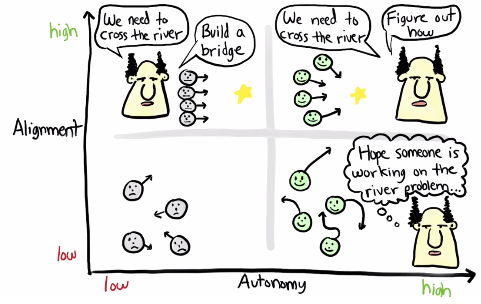The next big thing: autonomous, self-organized units (2)
08 Oct 23:29 Tags: Organisationsentwicklung, Agilität
This is the second article in the series The next big thing: autonomous, self-organized units, through which I would like to share my experience and make them accessible to to others in the same boat.
Product and unit vision

While searching for a new job recently, I came across a start-up in the education sector. Oh, how cool, I thought, pure intrinsic motivation. Everyone wants to work in the area of education in the best way to give something back to society.
Then I read through their mission statement. Hmm. “… fully exploit the learning potential …” and so on. In the interview I asked if this statement is sufficient to sharpen the company’s profile internally and externally? For example, can employees question their work - and such stuff. In response, I got a blank stare and the clear message that they actually don’t want to deal with something like a vision or even their own mission statement. Why? Because, everyone they said that knows what it’s all about. Which is, I asked? Education, isn’t that enough? Hmm, I did not say anything else.
Afterwards I had to ask again:
“Can your employees answer this question: What real value are you creating here every day?”
And started some kind of monologue:
“A strong vision with meaning could be that every child in Germany and beyond has the opportunity to … Think big!
The fantastic acquisition of reputation and a simple, cost-effective but effective marketing campaign might be to offer the product or a partial product for … ALG 2 (unemployment benefit) recipients free of charge. You cannot earn more money directly, but the trust and loyalty built on the new social profile could be immense!
People speak about you. You care, you encourage, you give your company a strong internal as well as external (social) profile and get the incredibly opportunity of building strong and sustainable loyalty from your potential customers.”
I’m getting goose bumps right now. You can see how important this is for me.
It’s all about engagement, intrinsic motivation, identification with the product and customers and avoiding meaningless activities.
A quite good developer in my former team stood in front of me one day and questioned - quite factually - whether a feature really fitted our vision? He was right. My God, I was so proud of the moment! Yes, I really was.
If you want to build a ship, don’t drum up people together to collect wood and don’t assign them tasks and work, but rather teach them to long for the endless immensity of the sea.– Antoine de Saint Exupery
A clear vision or at least a well defined mission statement is so important because …
- It let you think big!
- It creates alignment at the product and company level, giving a common orientation for every member of the unit and even the company
- It creates purpose, a strong intrinsic motivation
- It’s a guard rail and helps keep the staff focused on the tasks that really matters, on value creation for customers
- It lets us all go in the same direction and is therefore the basis of an autonomous unit
Maybe you ask yourself, what actually is the difference between a vision and a mission statement? So, check this out here: Mission Statement vs Vision Statement
A vision is pure inspiration and the first inside spark for a big fire of passion!
If a vision is missing or if the vision is misunderstood or not understood, this can lead people or departments in a company to work towards different goals. This is the result of a lack a common orientation, which inevitably leads to conflicts of interest, wasted resources, confusing products and from time to time to the failure of the product or even the company.
A serious vision can help to avoid business theater (many thanks for this great analogy, Lars ) within companies and business units, where everybody is busy and stressed but not actually working on value creation.
How to develop a vision
To formulate a unit related product vision, it may be helpful to use the SHIELD criteria as an aid:
Simple - easy to understand Huge - formulate a great, ambitious goal Important - addressing a real need Engaging - engage all stakeholders and unit members Long-term - oriented with the long term in mind Distributed - well known by all in the company
Get a common understanding of your company’s vision and derive your own product vision. Focus on the customer every time, the customer’s needs and value creation for customers. Forget the old approach of money, sales and turnover-related inside-out thinking and start thinking of customer related outside-in (see: https://hr-pioneers.com/). Why? Money isn’t the best basis for the sustainable motivation of employees.
A shared vision means that everyone in the business unit should be involved in the creation process. Everyone has to be aligned, evolve loyalty and start heading in the same direction!

See Spotify and Its Strong Engineering Culture.
Maybe get used to the 5 Whys technique to iterate to a good vision. And calm down, it doesn’t have to be the very best version right in the beginning.
Roman Pichler has a great understanding of product visions: 8 Tips for Creating A Compelling Product Vision | Roman Pichler
Most important: all unit member have to get behind it. Therefore, let them do it, give them the responsibility to create their own vision. Depending on the mastery and maturity provide leadership, trust, help and a big room for development.
The process of creating a shared vision is anything but simple. But is there anything simple what matters?
And now? A vision is definitively not enough for a strong alignment and a successful product development. And why needs every unit an own vision? Strange, isn’t it? Stay tuned …
